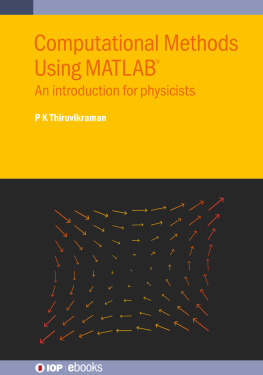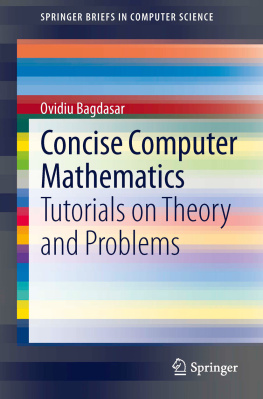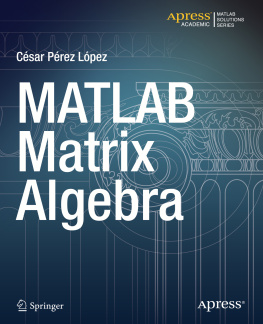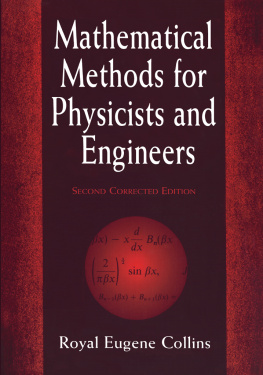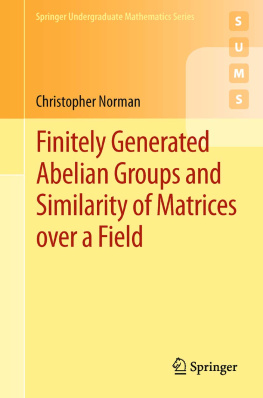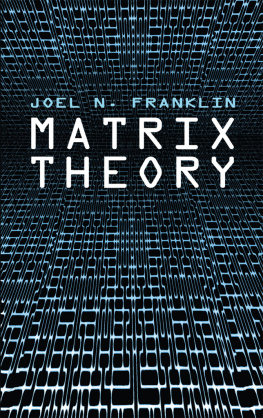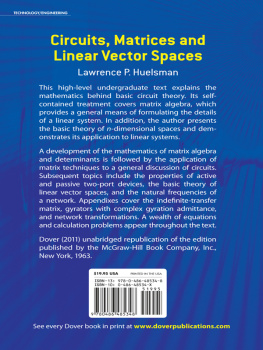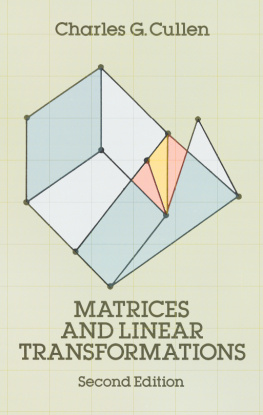Basic Matrix Theory
Leonard E. Fuller
Dover Publications, Inc.
Mineola, New York
Bibliographical Note
This Dover edition, first published in 2017, is an unabridged republication of the work originally published by Prentice-Hall, Inc., Englewood Cliffs, New Jersey, in 1962.
Library of Congress Cataloging-in-Publication Data
Names: Fuller, Leonard E. (Leonard Eugene), 1919-1994.
Title: Basic matrix theory / Leonard E. Fuller.
Description: Dover edition. | Mineola, New York : Dover Publications, Inc., 2017. | Originally published: Englewood Cliffs, N.J. : Prentice-Hall, 1962. | Includes bibliographical references.
Identifiers: LCCN 2017016532| ISBN 9780486818467 | ISBN 0486818462
Subjects: LCSH: Matrices.
Classification: LCC QA263 .F8 2017 | DDC 512.9/434dc23
LC record available at https://lccn.loc.gov/2017016532
Manufactured in the United States by LSC Communications
81846201 2017
www.doverpublications.com
Preface
This book has been written for the person who needs to use matrices as a tool; therefore, the mathematics involved has been kept at as simple a level as possible. Any person who has had elementary algebra and has a desire to learn something about matrices can understand the contents. To help the reader, many numerical examples are included to illustrate principles and techniques. Since matrices are viewed as a mathematical tool, throughout the book the emphasis is placed on developing skill in their use. No attempt has been made to give specific applications of the theory discussed because these are so varied that one cannot economically do justice to all of them for a given technique. The reader is urged to refer to the literature in his special area of interest for applications of the topics discussed.
The audience for which this text is intended is quite heterogeneous as can be seen by noting the backgrounds of the students in classes using the notes for this book. There were both undergraduate and graduate students enrolled for credit. The undergraduates were chiefly majors in mathematics, some of whom were planning to be high school teachers. The graduate students were in the various fields of engineering, the physical sciences, the social sciences, statistics, and plant and animal genetics, but no graduate students in mathematics were permitted to take the course. In addition to this group, there were several students and faculty members who audited the course. The faculty members were in the fields of engineering, statistics, mathematics, and genetics.
The material covered falls into two categories. The first four chapters contain the basic concepts of matrix theory, whereas the next three chapters are concerned with numerical computation techniques. The first chapters include topics that form the foundation for the remainder of the book. One of the most important of these topics is the concept of elementary operations. For each type, an easy to remember standard notation is given that also facilitates checking for errors in the reduction of matrices. A systematic procedure is outlined for simplifying matrices using elementary row or elementary column operations, or both. This basic procedure is then modified to give a method for evaluating the determinant of a given square matrix. Some of the numerical computation techniques that are considered also utilize the basic elementary operation process.
contain a few of the many standard numerical techniques with no pretense at completeness. Again a standard notation is developed and used throughout to make it easier to apply the processes. Both direct and iterative techniques for inverting matrices and solving systems of linear equations are considered. Detailed numerical examples are worked out to show how to apply each of these methods. The emphasis in these chapters is on understanding not only how to use the procedures but also why they are valid.
The author wishes to express his thanks to his wife Frances for her valuable assistance and her patience during the preparation of this book. He is also deeply indebted to Dr. R. G. Sanger for his careful reading of the manuscript and his many valuable suggestions and comments.
L.E.F.
Contents
1
Basic Properties of Matrices
1.1 Introduction
One of the most widely used mathematical concepts is that of a system of linear equations in certain unknowns. Such a system arises in many diverse situations and in a variety of subjects. For such a system, a set of values for the unknowns that will satisfy all the equations is desired. In the language of matrices, a system of linear equations can be written in a very simple form. The use of properties of matrices then makes the solution of the system easier to find.
However, this is not the only reason for studying matrix algebra. The sociologist uses matrices whose elements are zeros or ones in talking about dominance within a group. Closely allied to this application are the matrices arising in the study of communication links between pairs of people. In genetics, the relationship between frequencies of mating types in one generation and those in another can be expressed using matrices. In electrical engineering, network analysis is greatly aided by the use of matrix representations.
Today the language of matrices is spreading to more and more fields as its usefulness is becoming recognized. The reader can probably already call to mind instances in his own field where matrices are used. It is hoped that many more applications will occur to him after this study of matrix algebra is completed.
1.2 The Form of a Matrix
A proper way to begin a discussion of matrices would be to give a definition. However, before doing this, it should be noted that a simple definition cannot begin to convey the concept that is involved. For this reason, a two part discussion will follow the definition. The first part will be concerned with trying to convey the nature of the form of a matrix. The second part of the discussion will be concerned with the properties of what are called matrix addition, matrix multiplication, and scalar multiplication. This will establish the basic algebra of matrices. Consider the following definition.
Definition 1.1. A matrix is a rectangular array of numbers of some algebraic system.
What does this mean? It simply means that a matrix is first of all a set of numbers arranged in a pattern that suggests the geometric form of a rectangle. Most of the time this will actually be a square. The algebraic system from which the numbers are chosen will be discussed in more detail later. Some simple examples of matrices are as follows:

The [] that are used to enclose the array bring out the rectangular form. Sometimes large () are used, whereas other authors prefer double vertical lines instead of the []. Regardless of the notation, the numbers of the array are set apart as an entity by the symbolism. These numbers are often referred to as the elements of the matrix. The numbers in a horizontal line constitute a row of the matrix, those in a vertical line a column. The rows are numbered from the top to the bottom, while the columns are numbered from left to right.
It is sometimes necessary in a discussion to refer to a matrix that has been given. To avoid having to write it out completely every time, it is customary to label matrices with capital letters A, B, C, etc. as was done in the example above. In case the matrix being referred to is a general one, then its elements are often denoted with the corresponding small letters with numerical subscripts. The next example will illustrate this symbolism. With this notation one knows at once that capital letters refer to matrices and small letters to the elements.



